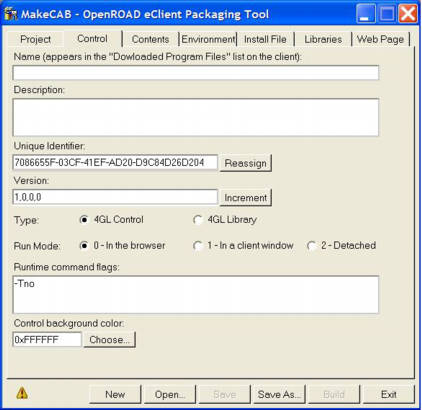Control Tab
The Control tab is for entering basic control information used by the OpenROAD eClient runtime to run the application. The contents are placed in the installation file that is part of your CAB file.
This tab contains the following fields and controls:
Name
(Required) Specifies a descriptive name for your application. This name is displayed in the “%SystemRoot%\Downloaded Program Files” directory.
Description
(Required) Specifies a complete description of the package
Unique Identifier
(Required) Specifies a GUID, a universal unique identifier for your package. This field is automatically generated. Use the Reassign button to generate a new GUID.
Note: After the package is published, you should not generate a new GUID because the connection to the original package will be lost. Instead, use the Version field to trigger clients to download a new version of the package.
Version
(Required) Specifies a mandatory comma-separated list of four numerical values that are used to indicate the version of the package. It is common to start with “1,0,0,0” and increase one or more of these numbers with each new release of the CAB. The four positions specify the major and minor numbers associated with a particular version of the application. For example, a version string of “1,2,3,4” could represent major release 1, minor release 2, version 3, fix level 4.
Changing this value, republishing the CAB, and updating all HTML pages to reflect the new version will trigger a download of the application on client workstations the next time they access the web page. Clicking the Increment button automatically increases the current version number.
Type
(Required) Specifies the type of application:
4GL Control
Only 4GL Control applications can be run.
4GL Library
Library applications are commonly used to distribute included images that represent the infrastructure of many applications. These images often change less frequently than the top-level applications.
For more information about using included libraries, see
Libraries Tab (see
Libraries Tab).
Run Mode
(Required for Type=4GL Control) Specifies the run mode for OpenROAD eClient applications:
Mode 0 (Runs inside the browser window)
Specifies that the application runs inside the browser window as if it is part of the HTML page. Child frames that the application accesses using the callframe statement appear directly in the browser and overlay the parent frame. Returning from the called child frame causes the parent frame to be redisplayed. Child frames accessed by the openframe statement will open in their own client windows.
Note: Closing the browser will cause the application to terminate unconditionally. Because of restrictions in Microsoft's implementation of Internet Explorer, it is not currently possible to trap this event. Reloading the browser page will cause the application to restart, and using the Back or Forward button will cause the application to terminate.
In mode 0, the eClient cannot display menu bars, toolbars, or status bars because these window areas are owned by Internet Explorer. If your application uses any of these constructs and they are essential for the navigation and use of your application, you first must make changes to the OpenROAD application. Menu bars can be emulated on the top form of an OpenROAD user frame with pop-up buttons. Toolbars can be redrawn on the top form. A user-written status bar is necessary to replace the OpenROAD status bar. Child frames that are opened using the openframe statement and applications running in Mode 1 or 2 do not carry this restriction and do not need to be modified.
Mode 1 (Runs as a separate client window)
Specifies that the application runs as a separate client window attached to the browser process. Like Mode 0, closing the browser will terminate the OpenROAD eClient application. Otherwise, the visual behavior of a Mode 1 application is identical to a traditional OpenROAD client application.
Mode 2 (Runs in its own window)
Specifies that applications run in their own window detached from the browser process. Closing the browser has no effect on the application.
Runtime command flags
(Optional) Specifies any runtime flags that are passed to the OpenROAD eClient application when it is run. This field may contain any of the flags that are allowed by the OpenROAD w4glrun command.
Control background color
(Required) Specifies the hexadecimal background color using the format “0xNNNNNN”. For example, use 0xFFFFFF for white. To open a color selection dialog containing hexadecimal codes and descriptions, click Choose.
Note: The hexadecimal representation uses the HTML-based color representation. The information included in the installation file converts this information to the OLE control hexadecimal color format.

